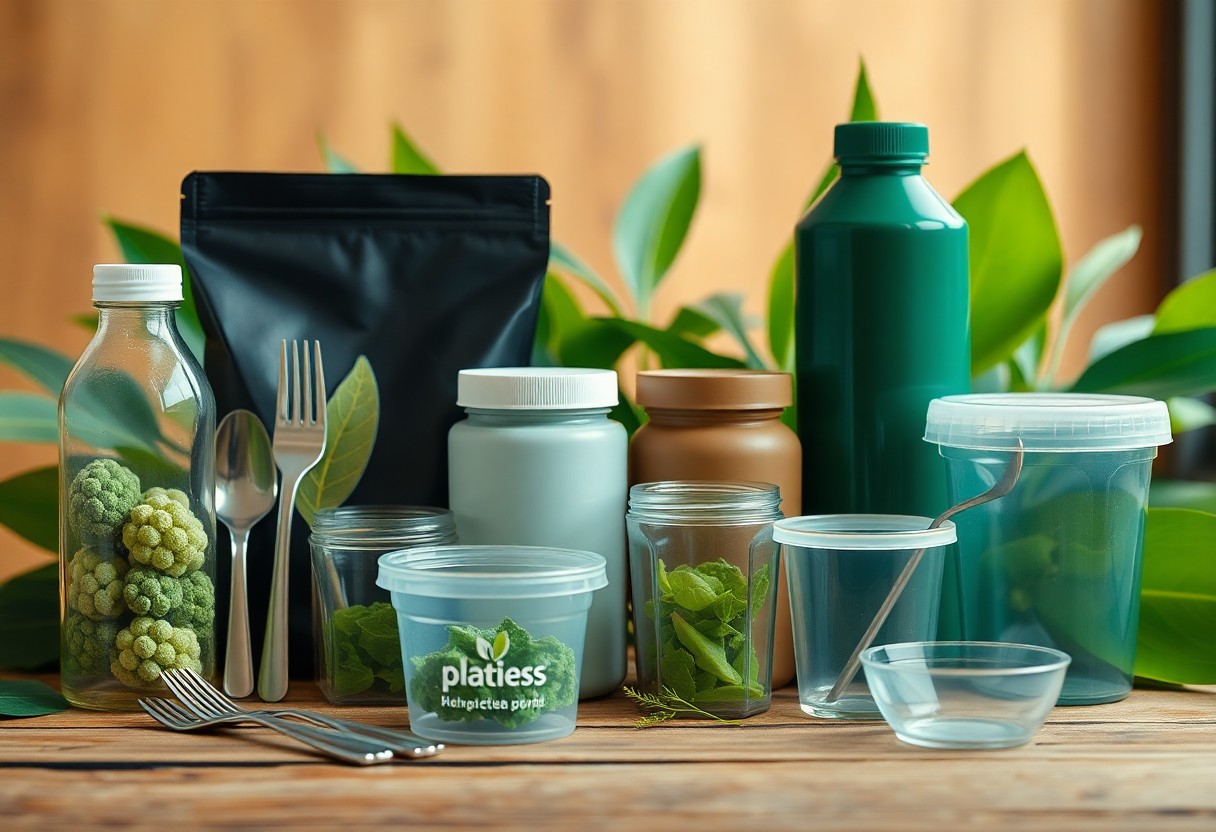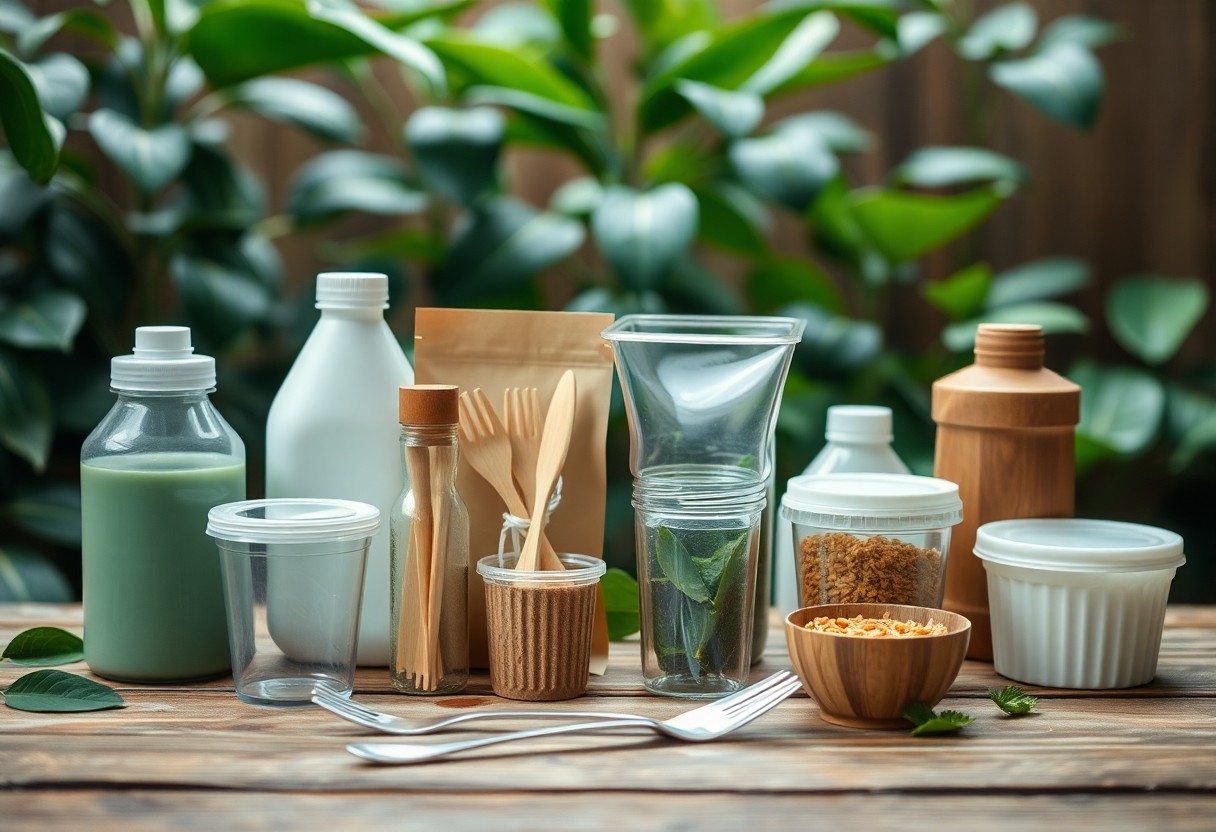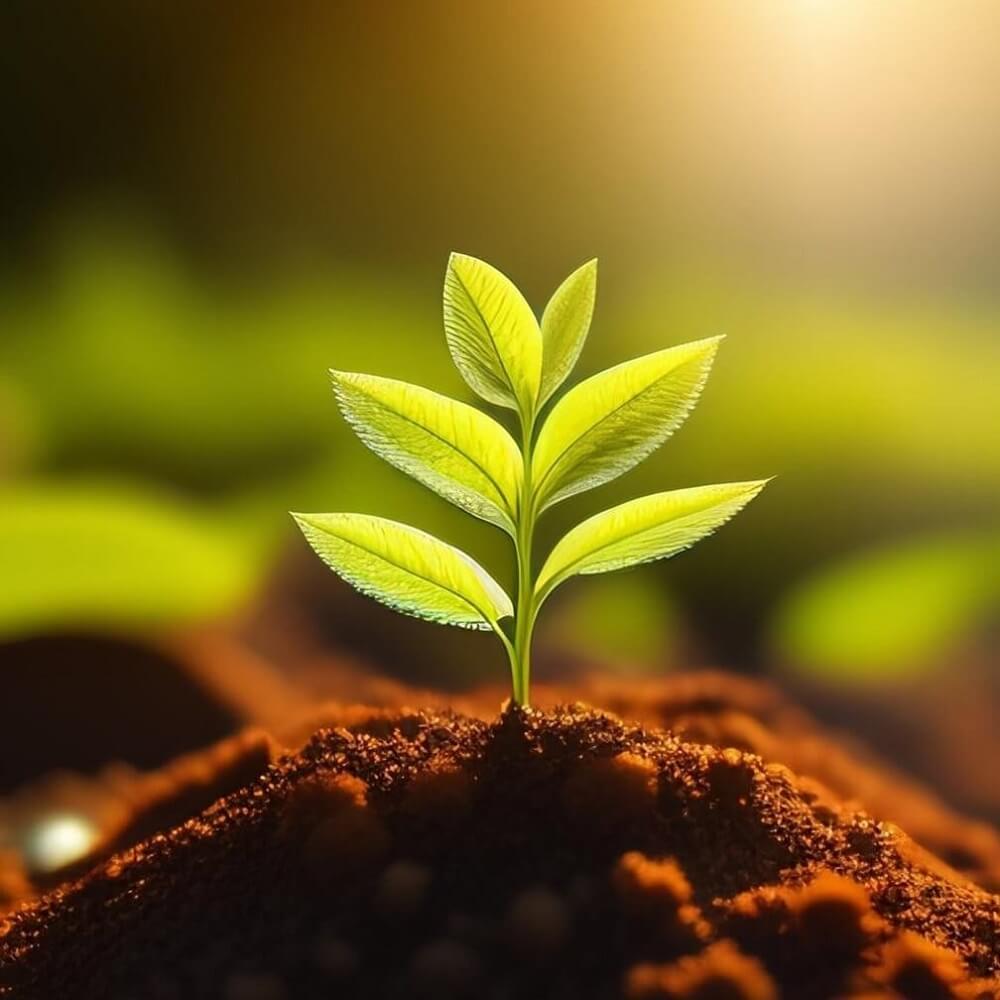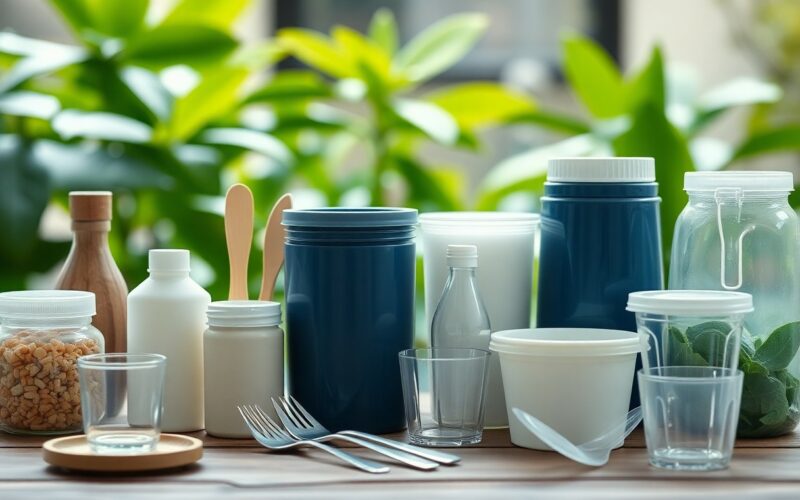Over time, the demand for sustainable materials has led to the rise of bioplastics, which are derived from renewable plant sources instead of traditional petroleum-based plastics. In this post, you will learn about how plant-based plastics are made, their environmental benefits, and some of the challenges you may encounter in their use. Understanding bioplastics not only helps you make informed decisions but also empowers you to contribute to a greener future by reducing reliance on fossil fuels and minimizing plastic waste.
Table of Contents
Key Takeaways:
- Bioplastics are derived from renewable plant materials, such as corn starch or sugarcane, making them more sustainable compared to traditional petroleum-based plastics.
- These materials can be designed to either biodegrade or be composted, reducing their environmental impact and helping to alleviate plastic pollution.
- Bioplastics offer similar physical and chemical properties to conventional plastics, enabling their use in a wide range of applications, from packaging to automotive parts.
Understanding Bioplastics
For individuals seeking sustainable alternatives, bioplastics represent an innovative solution by utilizing renewable resources. These eco-friendly materials are made from biological substances rather than traditional petroleum-based plastics, offering potential benefits for the environment and society.
Definition of Bioplastics
The term bioplastics refers to plastics that are either derived from renewable biomass sources or are designed to be biodegradable. This dual nature distinguishes them from conventional plastics, which are solely petroleum-based and can take hundreds of years to decompose.
Types of Bioplastics
Above all, bioplastics can be categorized into two primary types: bio-based and biodegradable. Below is a summary of their distinct characteristics:
| Type | Description |
|---|---|
| Bio-based | Plastics made from renewable biological materials. |
| Biodegradable | Plastics that can break down and decompose in natural environments. |
| Both | Materials that are both bio-based and biodegradable. |
| Conventional Petrochemical | Derived from fossil fuels and resistant to decomposition. |
| Specialty Bioplastics | Plastics designed for specific applications. |
Perceiving these types allows you to understand the diverse applications and benefits of bioplastics, enhancing your knowledge of sustainable materials.
Hence, exploring the various types of bioplastics provides insights into their unique properties and uses. These can be classified as follows:
| Type | Examples |
|---|---|
| PLA (Polylactic Acid) | Commonly used in packaging and disposable tableware. |
| PHA (Polyhydroxyalkanoates) | Used for medical applications due to biocompatibility. |
| Starch-based Plastics | Often used in agricultural films and packaging. |
| Cellulose-based Plastics | Found in films and coatings. |
| Other Bio-based Plastics | Combine different renewable sources for diverse applications. |
Perceiving the potential of these bioplastics highlights their impact on minimizing plastic pollution while fostering sustainable practices.

Sources of Plant-Based Plastics
The primary sources of plant-based plastics include diverse raw materials derived from plants, such as corn, sugarcane, and potatoes. These materials undergo processing to create Bioplastic resins that can replace traditional petroleum-based plastics in various applications.
Raw Materials Used
Before you examine into the world of bioplastics, it’s important to understand the raw materials that are predominantly utilized. Examples include starch from crops like corn and potatoes, as well as cellulose derived from wood and agricultural residues.
Renewable Resources
The advantages of using renewable resources for bioplastics are significant. They offer a sustainable alternative to fossil fuels, helping to reduce your carbon footprint.
Due to the reliance on renewable resources such as agricultural products, bioplastics can contribute to a more sustainable future. By using materials that are replenishable, you can help reduce the dependency on non-renewable resources. Furthermore, utilizing these resources often leads to decreased greenhouse gas emissions during production, supporting a healthier environment. However, it’s important to consider potential challenges, such as the impact on food supply and biodiversity when choosing sources for these bioplastics.

Production Process of Plant-Based Plastics
Unlike conventional plastics, plant-based plastics undergo a unique production process that begins with renewable materials. These sustainable resources are transformed into bioplastics through various methods, allowing for a reduction in dependence on fossil fuels. To understand more about this innovative approach, check out What is Plant-Based Plastic and How it Works.
Extraction and Processing
An imperative first step in creating plant-based plastics involves the extraction of natural polymers from plant sources, such as corn, sugarcane, or potatoes. These materials are processed to isolate the starch or cellulose, which forms the foundational components of bioplastics.
Manufacturing Techniques
About the manufacturing techniques, various methods are employed to convert extracted materials into usable forms. Techniques such as extrusion, injection molding, and blow molding are utilized to shape the bioplastic, ensuring versatility in its applications.
Even though manufacturing techniques vary, they share a common goal of creating high-quality, durable products. The processes often involve melting and cooling the bioplastic materials, which efficiently shape them into desired forms. Important to consider is that for optimal performance, you may encounter specific challenges related to temperature and moisture, requiring careful monitoring. Nevertheless, the environmental benefits of using renewable resources significantly outweigh these challenges, contributing to a more sustainable future in material manufacturing.

Applications of Plant-Based Plastics
Your potential use of plant-based plastics spans various sectors, showcasing their versatility and sustainability. These innovative materials are finding applications in consumer goods, packaging, automotive parts, and even construction materials, allowing you to make environmentally conscious decisions without compromising functionality.
Consumer Goods
Below are several examples of consumer goods incorporating plant-based plastics, such as biodegradable cutlery, food containers, and toys. These products cater to an eco-aware market, allowing you to reduce your carbon footprint and support sustainable alternatives to traditional plastics.
Industrial Uses
Against the backdrop of environmental concerns, plant-based plastics offer promising solutions in industrial applications, including packaging materials, automotive components, and construction products. Their potential lies in replacing traditional plastics, thereby reducing dependence on fossil fuels and minimizing waste.
Even in industrial settings, plant-based plastics prove to be both feasible and affordable, providing an eco-friendly alternative. They are not only renewable, derived from sources like corn starch and sugarcane but also offer durability and performance similar to their petroleum-based counterparts. With the growing need for sustainable practices in industries, adopting these materials will help you contribute toward reducing greenhouse gas emissions and fostering a healthier planet.
Environmental Impact of Bioplastics
Once again, the environmental impact of bioplastics can be misleading. While they are often marketed as an eco-friendly alternative, plant-based bioplastics are not as ‘green’ as some think. Their production may still contribute to deforestation and land-use changes, and they do not always break down effectively in natural environments. Understanding these factors is crucial for making informed choices about materials you use in your daily life.
Benefits Over Conventional Plastics
Above all, bioplastics offer several advantages when compared to conventional plastics. They are often made from renewable resources, potentially reducing reliance on fossil fuels. Furthermore, many bioplastics have a lower carbon footprint during production. This eco-friendliness can help mitigate some of the issues associated with plastic waste, as they can sometimes provide an alternative that is more sustainable.
Challenges and Limitations
The challenges and limitations of bioplastics are significant. Despite their benefits, these materials can still contribute to environmental issues.
Even though bioplastics are made from renewable resources, their production can lead to land-use changes that impact biodiversity negatively. Additionally, not all bioplastics are biodegradable, and many require specific conditions to break down properly, leading to mismanagement in waste systems. The cost of bioplastics is often higher than conventional plastics, which can limit adoption. Ultimately, while bioplastics represent a step towards sustainability, it is important to weigh their benefits against their limitations to make the best choices for the environment.
Future of Plant-Based Plastics
After witnessing rising environmental concerns, the future of plant-based plastics looks increasingly promising. These innovations not only offer sustainable alternatives to traditional plastics but also pave the way for a more eco-conscious society. As technology continues to advance, you can expect widespread adoption and increased production capabilities, driving costs down and making bioplastics a viable option for various industries.
Innovations in Bioplastic Technology
Beside ongoing research, significant advancements in bioplastic technology are being made. New materials are being developed that enhance the properties of bioplastics, making them as durable and versatile as their petroleum-based counterparts. You might find innovations such as biodegradable additives and improved recycling processes are transforming how you perceive and use plastics in your daily life.
Market Trends and Predictions
Behind the scenes, market trends indicate a shift toward bioplastics in consumer preferences. Awareness around sustainability continues to rise, prompting many businesses to adopt plant-based materials. You can anticipate increased investments in bioplastics and a sustainable product-driven market. As consumer demands evolve, industries are likely to pivot towards more eco-friendly options, creating a landscape rich in bioplastic innovation.
Future reports suggest that bioplastics will capture a significant share of the global plastic market, driven by the environmental benefits and consumer demand for sustainable products. Major industries, including packaging, automotive, and textiles, are expected to incorporate plant-based materials at an accelerated pace. This trend could play a key role in reducing plastic waste and lowering carbon footprints. However, it is important to monitor how these advancements impact your daily life and the precious resources needed for production.
To wrap up
So, as you explore the world of bioplastics, you’ll discover that plant-based plastics offer a sustainable alternative to traditional petroleum-derived materials. By understanding how their composition and properties work, you can make informed choices that contribute to environmental preservation. Embracing bioplastics not only benefits your lifestyle but also plays a part in reducing plastic pollution and promoting a circular economy. Investing your knowledge in this innovative field empowers you to be a responsible consumer in today’s eco-conscious world.
FAQ
Q: What is bioplastic and how does it differ from traditional plastic?
A: Bioplastic refers to a type of plastic that is derived from renewable biomass sources, such as vegetable fats, corn starch, or sugarcane. Unlike traditional plastics, which are petroleum-based and can take hundreds of years to decompose, bioplastics can be designed to be biodegradable or compostable, making them less harmful to the environment. However, not all bioplastics are biodegradable; some are designed to have similar properties to conventional plastics while still being produced from renewable resources.
Q: How is plant-based plastic made?
A: Plant-based plastic is typically made through a process that involves converting plant materials, such as starch or sugar, into polymers. The process usually begins with extracting the sugar or starch from plants, which is then fermented by microorganisms to produce lactic acid. This lactic acid can be polymerized to create polylactic acid (PLA), a common type of bioplastic. Alternatively, plant oils can be chemically modified to produce biopolymers that are suitable for various applications.
Q: What are the environmental benefits of using plant-based plastics?
A: The use of plant-based plastics has several environmental advantages. Firstly, they help reduce our reliance on fossil fuels, as they are made from renewable resources. Secondly, many bioplastics can be biodegradable or compostable, which means they can break down naturally and reduce landfill waste. Additionally, cultivating plants for bioplastics can also contribute to carbon capture, as plants absorb carbon dioxide from the atmosphere during their growth. This can lead to a smaller carbon footprint when compared to traditional plastic production.
Q: Are there any downsides to using bioplastics?
A: While bioplastics offer many benefits, there are potential downsides to consider. Some forms of bioplastic may not biodegrade easily in natural environments without specific conditions, leading to concerns about their impact if they end up in landfills. Furthermore, the production of bioplastics can compete with food production, as crops used for bioplastic may take up valuable agricultural land and resources. Additionally, the processing and transportation of raw materials for bioplastics may still generate greenhouse gas emissions.
Q: In what applications can plant-based plastics be used?
A: Plant-based plastics are versatile and can be used in a wide range of applications. Common uses include packaging materials, disposable cutlery, plates, and bags, as well as textiles and consumer products. Bioplastics are also being explored for use in more complex applications, such as automotive parts and medical devices, where their lightweight nature and potential for biodegradability offer an innovative alternative to conventional plastics. As technology and materials improve, the potential applications for bioplastics will likely expand even further.

Our contributing author is a passionate advocate for eco-friendly living and sustainability. With a background in eco-life, they are dedicated to inspiring and empowering individuals to adopt environmentally conscious lifestyles. Through insightful articles, they share practical tips, innovative solutions, and thought-provoking perspectives to promote a greener, more sustainable world. Join them on the journey towards eco-smart living and discover how small choices can make a big impact. 🌱








